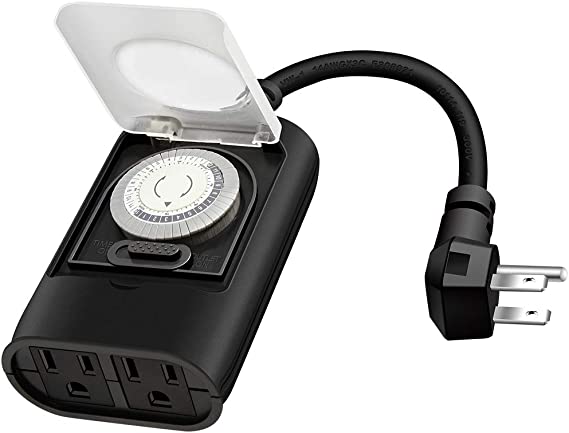Running your block heater in the winter is something we all know we need to do, but for how long? It turns out to be a simple answer, with a small variable.
Block Heater vs Oil Warmer
Before we get in to how long it needs to run, we need to clarify a Diesel Myth out there. That myth being your Block Heater is supposed to warm up your oil. This is not the case at all.
A Block Heater is just that, a small electric heating element that warms up your engine block. It is installed in one of the antifreeze passages in your engine. Your oil pan is on the very bottom of the engine.
The function of the block heater is to work like an electric water heater, and warm the coolant in your engine. By keeping the block warm, it makes it easier for your engine to start when the temperatures are below freezing.
An oil warmer is the same thing, but for your oil pan. There are different styles that you can add on yourself. One is a replacement oil dipstick with a heating element on the tip. The other is a flexible pad that you stick on to the bottom of your oil pan.
Which one is better for winter engine starts? Well that depends.
What Do Oil Numbers Mean?
When you get oil for your car or truck, the bottle it comes in usually has two numbers on it. Most of us just get whatever the engine oil cap says on it and don’t give it much thought after that.
Today’s oils are much more than melted dinosaurs in a bottle, which is why they have two numbers on that bottle. They are engineered to have different properties based on their temperature.
Let’s use a bottle of 10/30 for example. The first number is the cold viscosity. The second number is the hot viscosity. Viscosity is kind of like your blood pressure, there is a golden zone for your engine, just like for your heart.
The lower the viscosity, the thinner the oil, the easier it flows in cold temperatures. Gear oil for example has a viscosity of 90. If you tried pouring gear oil in your engine and starting it on a minus 20 day, that would be like eating nothing but fried foods your whole life then suddenly running a 5K.
Once your engine is warmed up, it’s ready to really get going, so your oil can be a little thicker and still flow where it needs to. Just like you and me, when we first wake up and are drinking our coffee reading one of our fantastic articles, our blood pressure is low.
After we’ve had a few cups, and knocked the rust off our joints, we can take the dog for a run across the park. Our blood pressure is going to go up, but that’s ok because we are all warmed up.
So why an Oil Warmer?
Some of the old timers, and even some of us medium timers, have that old truck that they just won’t get rid of no matter how many oil spots are in the driveway. For me it was my old Ford with the International 7.3 Diesel engine.
That truck didn’t care what you put behind it, it was gonna pull it like it wasn’t even there. It just leaked like a spaghetti strainer until it was warmed up. The back yard mechanic solution was to run a thicker oil in it. Instead of 10/30, I would run 20/30 so the oil is thicker when it’s cold out to prevent the leaks.
When the temperatures got below freezing, the truck was a little cranky about having to go to work in the morning. Can’t say I blame it, I was too!
The other solution is to use an oil warmer, keep running the same oil, and keep it in the warmer viscosity zone. By heating the oil pan, and the oil in it, some heat will rise into the engine and make starting it a little easier too.
The down side to the oil warmer is the oil pan location. Being on the very bottom of the engine, when it is windy out, that wind blows under the truck and sucks the heat out of the oil pan. You also end up with different temperatures in your engine.
The bottom of your engine will be warmer than the top, which in itself can lead to more leaks. When metals heat and cool they expand and contract. The gaskets between the warmer bottom and cold top of your engine may fail due to the uneven heating.
How Is A Block Heater Different?
The block heater is installed more in the “middle” of your engine’s overall height. It is also installed directly into the coolant passage. Water/Antifreeze is an excellent heat conductor, which is why it’s used to keep your engine running cool.
When your block heater is plugged in, the heating element starts to warm up the coolant that is touching it. That heat naturally radiates out to the rest of the coolant, as well as to your metal engine block.
On some vehicles it MAY even warm the oil. In some vehicles it may not. It all depends on the design of the engine. Either way, when you start your engine, the oil is pumped through all of its passages in your engine and almost instantly absorbs the heat that was built up from your block heater.
So how long do I need to run my block heater?
After scouring the internet to find the balance point between maximum heating and just wasting electricity, the consensus seems to be 4 hours. After 4 hours your block heater isn’t going to get your block any warmer due to the heat being lost to the natural cooling of the cold air.
On my old 7.3 the longer it was plugged in, the warmer it was the next morning, which made both of us less cranky about going to work. If I left it plugged in all night, the following morning the heat instantly blew hot air.
That is not the case with our new 6.7 Ford. It still takes about 5 minutes before the air blows out what I would call Hot.
Most of todays diesels will start just fine down to 20 degrees Fahrenheit. Ours is a little more chattery but It starts right up. When the temp is below freezing I used to add plug the truck in to my morning routine. I would get up at 5 or 6, plug it in, and when we were ready to head out for the day at 7 or 8, she was ready to run.
There has to be a better way
I have always liked gadgets, and making life easier, and avoiding being cold whenever I can. For all of those reasons I started using a timer. Now I can drink my coffee and just look out the window while it’s snowing in the morning.
This timer is great. You set the time you want it to come on, and the time you want it to turn off. For us its On at 5am and turns Off at 9am. So now when we get home for the day, we just plug the truck in. Set it and forget it.
No more remembering to go outside 4 hours before work. No wasting electricity when the block heater is running when it doesn’t need to be. The absolute best part?
There is ZERO chance of me forgetting to plug the block heater in early enough. No dead battery from cranking too long. Zero chance of a cracked block from thermal shock. We save money on diesel because the remote start isn’t running for 10 minutes every day. No matter where we go, we can just plug our timer into the pedestal at the campground, plug the truck in at night, and know we are good to go in the morning.
Don’t forget to read: 22 Must Have’s For Full Time RV Living





